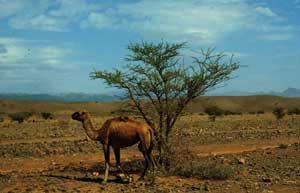|
|
 3 camel and non-ant-acacia DHJanzen100085.jpg high resolution
|
|
| The four plant ingredients for the coevolution of the mutualism described in the acacia-ant lecture are Acacia trees (Fabaceae) with thorns coevolved with browsing mammals, Acacia trees with foliar nectaries (or extra-floral nectaries as they are also called), Acacia tree leaves per se that evolved into food bodies and may be retained even in dry weather (see below). The animal ingredients are herbivores, and Pseudomyrmex ants (Formicidae) living in hollow twigs (in the neotropics - in Africa, they are ants of the genus Crematogaster). These ingredients were present in both the African tropics (this photograph) and the New World tropics (or neotropics as they are often called), and in both cases led to the independent coevolution of an obligatory acacia-ant mutualism. In this lecture we are dissecting the neotropical mutualism, but I happen to have a photograph of two of the ancestral ingredients together in Morocco in their native continent, a photograph impossible to take in the neotropics, owing to the human-caused extinction of most of the neotropical megafauna about 11,500 years ago. They are also in the kind of habitat - arid lands and tropical dry forest - where this interaction may have evolved, but more likely at the wetter and more forested end of the dry-to-wet gradient. | ||
back to lecture slides
or skip to: